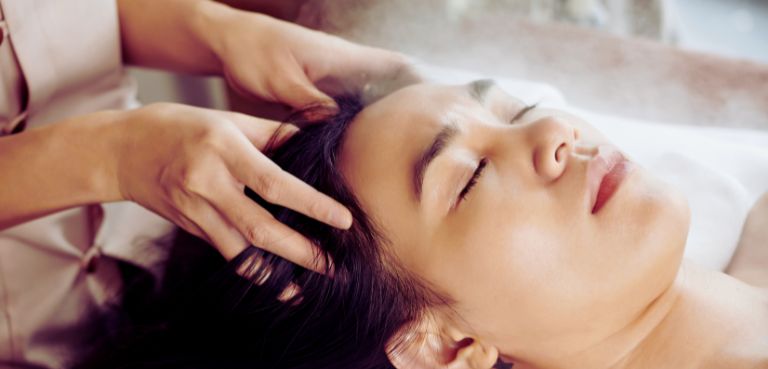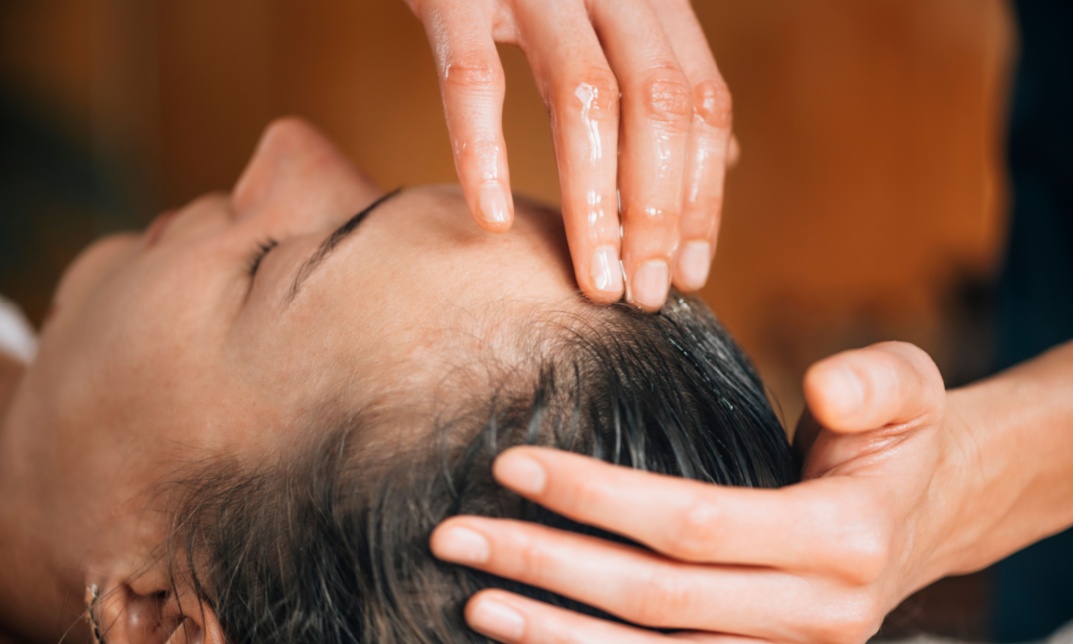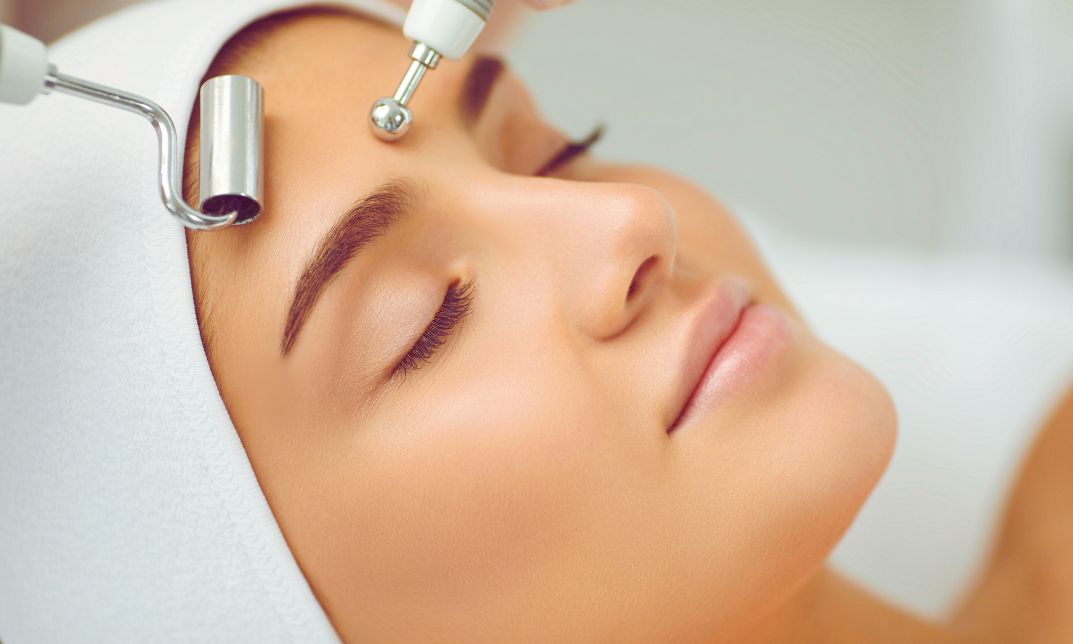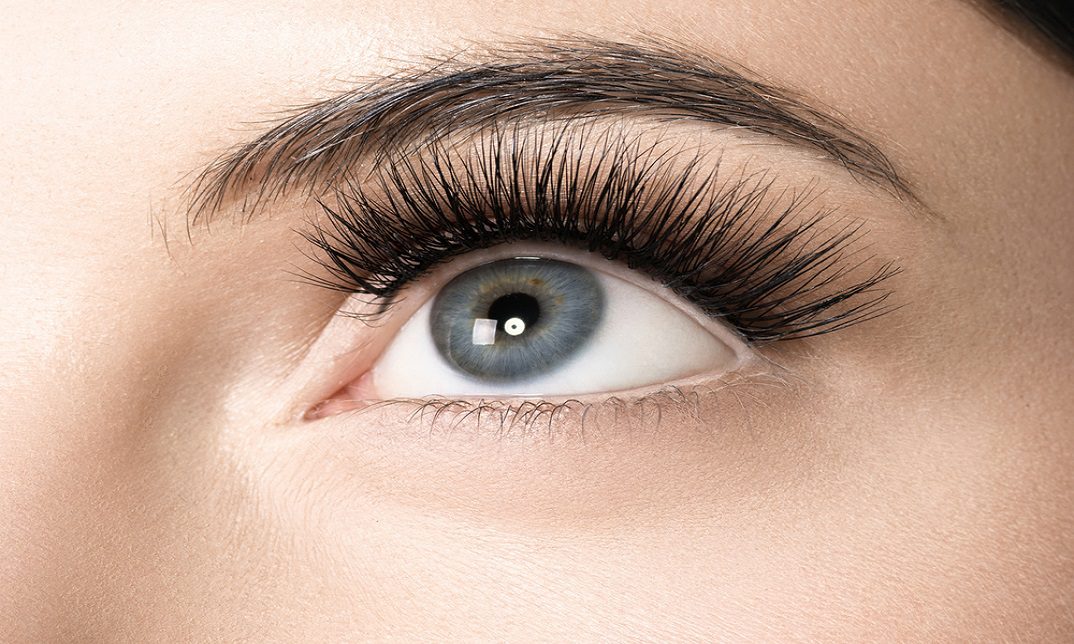No products in the basket.
Tension has a sneaky way of building up in our heads, necks, and shoulders — but the Indian Head Massage offers a natural way to release it. Indian Head Massage, also known as ‘Champissage,’ is a deeply relaxing therapy that focuses on the scalp, neck, shoulders, and upper back. Rooted in ancient Ayurvedic traditions, this kind of massage for the head has been used for centuries to improve overall well-being by easing stress, improving circulation, and restoring balance to the body. Today, many spas and wellness centres around the world offer Indian Head Massage as a simple and natural way to calm both the body and mind.
What Is An Indian Head Massage?
An Indian head massage, or ‘champissage, ’ is a healing technique that focuses on massaging the scalp, neck, shoulders, and upper back. It originates from the ancient Ayurvedic and is performed with the purpose of relieving stress, improving circulation, and enhancing overall well-being. This massage technique is designed to target areas where tension builds up, helping to relax the mind and body. It is commonly used as a natural remedy to reduce fatigue and tension headaches and even improve mental clarity.
The Origin Of The Indian Head Massage
Indian head massage dates back to somewhere around 600 BC and has been practised in India for over a thousand years. It was used as part of a family custom, where techniques were passed down through generations. The practice was integrated into Ayurvedic medicine, which focuses on balancing the body’s energy and promoting self-healing. Over time, it has become a popular holistic treatment around the world.
Now, it is popularly performed in spas, wellness centres, and even workplaces to help alleviate stress and improve overall health. Moreover, it has even become popular in most of the western countries for its relaxing massage that relieves stress and relaxes the mind.

The Purpose of the Massage
The main purpose of an Indian Head Massage is to relieve tension and stress while improving general well-being. This sort of massage promotes happiness while decreasing stress and anxiety. This massage focuses on the underlying causes of pain by rubbing the affected regions.
How Is An Indian Massage Performed?
An Indian head massage mainly focuses on connecting your mind and body and bringing them into a state of calm. Moreover, to improve the experience of the therapy session, the therapist will play soft music in order to create a calm and soothing atmosphere. The massage doesn’t require you to take your clothes off, but you should wear something that’s loose-fitting so that the therapist can work easily.
Before starting, the therapist makes sure their hands are warm and smooth, which helps make the experience more soothing. The massage consists of different kinds of techniques such as friction, tapping, stretching, and circular motions. Each of these techniques has advantages of its own; for example, they ease tension and stimulate relaxation. The therapist will usually start with a grounding process, where they will guide you to take a few long breaths.
The treatment normally starts at your shoulders and upper back, working its way down the arms before moving up to your head, scalp, and face. Below is a breakdown of the process. During the massage, you might experience:
- Soft kneading and pressure on your neck and shoulders to ease any stiffness.
- Gentle tapping, squeezing, or rubbing your scalp.
- Applying pressure to certain spots on your face to relieve sinus pressure.
- Lightly pulling or pressing on your ears to release any tension.
Do you use Oils for Indian Head Massage?
Although optional, oils are often used during an Indian head massage. In the massage, many kinds of oils are used. Popular choices include coconut, almond, and sesame oil, each having its unique benefits. However, the massage can also be performed without oil if preferred, making it suitable for those with sensitive skin or specific allergies.
Do you need any Massage Tools for the Indian Head Massage?
Since the therapist mostly uses their hands when performing various massage techniques, no special tools are needed for this treatment. However, some may choose to use a scalp massager for added stimulation, but it’s not required. Traditional Indian Head Massage relies on the therapist’s ability to manipulate pressure points and energy pathways, making the hands the most effective tool.
Can Indian Head Massage Cause Headaches?
While it is generally beneficial, some individuals may experience mild headaches after a session. This is usually due to increased blood circulation and the release of toxins. The body’s response to deep relaxation and muscle manipulation can sometimes trigger temporary discomfort. Drinking water after the massage can assist in flushing out the toxins and avoiding headaches.
What are the Benefits of Indian Head Massage?
Below are a few benefits:
Physical Benefits
- Relieves Insomnia: Indian head massages can help people with insomnia by lowering tension and encouraging relaxation, which improves the quality of their sleep. The calming effects of the massage allow the body to fully relax, which helps with falling asleep and staying asleep.
- Reduces Sinusitis: People with sinusitis may feel better after an Indian head massage because the gentle movements can help drain mucus and clear blocked sinuses. Moreover, light pressure on the sinuses and temples can ease congestion and make it easier to breathe.
- Aids in the Relief of Migraines: By reducing muscle tension and improving blood circulation, it can help decrease the frequency and intensity of migraines. It helps release tension stored in the head, neck, and shoulders, which are common areas where migraine pain originates.
- Stimulates Lymphatic Drainage: The massage encourages the movement of lymphatic fluids, which helps remove toxins and boost the immune system. This process aids in reducing swelling and promoting overall body detoxification.
- Promotes Hair Growth: Scalp massage stimulates hair follicles, improving blood flow and promoting healthier hair growth. Regular stimulation helps reduce hair loss and maintain a nourished scalp.
Psychological Benefits
- Relieves Symptoms of Anxiety and Depression: The calming effects of Indian Head Massage can help reduce anxiety and improve mood, making it a valuable therapy for mental well-being. The release of endorphins during the massage helps uplift the mood and reduce stress levels.
- Improves Memory Capabilities: By enhancing blood circulation to the brain, Indian Head Massage can improve focus, concentration, and memory. The improved oxygen supply allows the brain to function more efficiently, enhancing cognitive abilities.

What are the Effects and Disadvantages of this?
- Persistent Migraines or Headaches: Although the massage helps many people, some may experience persistent headaches, especially if they are sensitive to pressure. If headaches continue, reducing the intensity of the massage may help.
- Severe Muscle Pain: Excessive pressure during a massage might create muscular tightness or discomfort. It is critical to speak with the therapist to ensure that the appropriate pressure is administered.
- Dizziness: Some individuals may feel dizzy after a session due to increased blood flow and relaxation. Standing up slowly after the massage can help prevent this.
- Irritation: Using oils can occasionally cause skin irritation or allergic responses. Before beginning a session, check for sensitivities.
- Urinating More: Since the massage stimulates the lymphatic system, it can lead to increased urination as toxins are flushed out of the body. This is a natural detoxification process.
Who should not have an Indian Head Massage?
- High Blood Pressure: Those with uncontrolled high blood pressure should consult a doctor before having a massage, as it may affect circulation.
- Epilepsy: Individuals with epilepsy should avoid this massage as it could trigger a seizure.
- Diabetes: People with diabetes should be cautious, as the massage may affect blood sugar levels.
- Thrombosis: Since the massage stimulates circulation, those with thrombosis or a history of blood clots should seek medical advice before undergoing treatment.
- Cancer: Cancer patients should consult a doctor before having an Indian Head Massage, as it may interfere with treatments.
- Cuts and Sores: If there are open wounds or infections on the scalp or neck, it is best to wait until they heal before having a massage.
- Pregnancy: Pregnant women should avoid Indian Head Massage in the first trimester, as it may stimulate pressure points that could affect pregnancy.
Conclusion
Indian Head Massage is a traditional way to relax and feel better. It helps reduce stress and can make your body and mind feel calmer. This type of massage uses gentle movements to improve blood flow, ease headaches, and relax tight muscles. You can enjoy it as part of your daily self-care or just when you need a break. It’s a simple and natural way to feel more balanced and peaceful without many risks.
FAQs
How long does an Indian Head Massage session last?
A session usually lasts between 30 to 45 minutes, depending on individual needs.
Can I wash my hair after an Indian Head Massage?
Yes, but it is best to wait a few hours to allow the oils to nourish your scalp before washing your hair.
How often should I have an Indian Head Massage?
It depends on individual needs, but weekly or monthly sessions are recommended for best results.
Is Indian Head Massage painful?
No, the massage should be gentle and relaxing. However, some people may feel slight discomfort if they have tension in their muscles.
Can children have an Indian Head Massage?
Yes, but it should be performed with gentle pressure, and parental consent is required.






